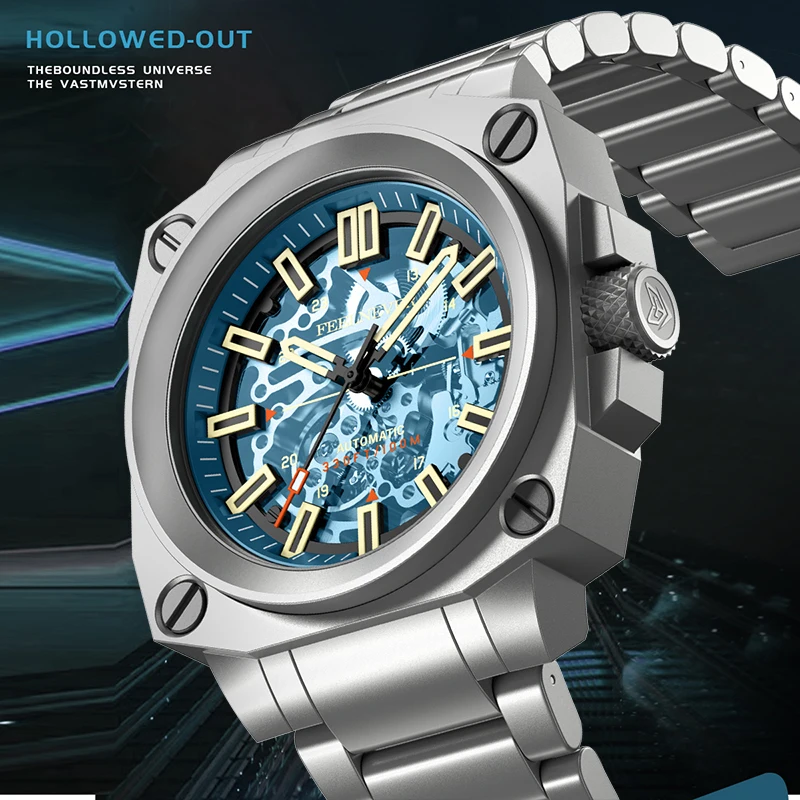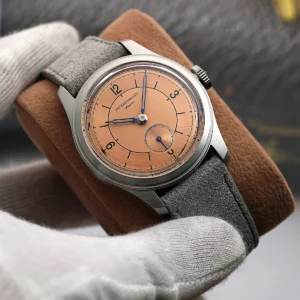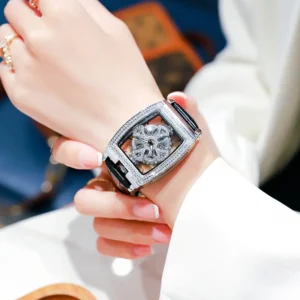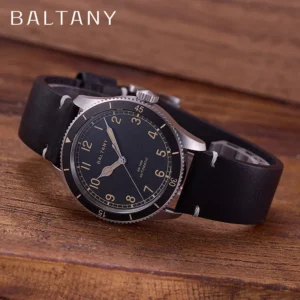Introduction: The Intersection of Aviation and Horology
The relationship between aviation and timekeeping has always been symbiotic. Since the early days of flight, pilots have relied on precise timepieces to navigate, calculate fuel consumption, and coordinate complex flight operations. Chronograph watches—timepieces with stopwatch functionality—emerged as essential tools in the cockpit, offering pilots the ability to time intervals with precision while maintaining awareness of the current time.
At the heart of every pilot’s chronograph lies one of two fundamental movement types: manual or automatic. This distinction goes beyond simple winding mechanisms, affecting everything from the watch’s profile and weight to its operational reliability and tactile experience. For aviation enthusiasts and watch collectors alike, understanding these differences isn’t merely academic—it can significantly impact both the practical utility and emotional connection to these precision instruments.
This exploration will delve into the mechanical differences, performance variations, and practical implications of choosing between manual and automatic chronographs for aviation use, drawing on the rich history of dive watch engineering that shares many principles with pilot timepieces. Whether you’re an active pilot seeking a reliable instrument or a collector appreciating horological craftsmanship, this comparison will help navigate the complex world of pilot chronographs.
Understanding Chronograph Movements: The Basic Mechanics
Before diving into the specific differences between manual and automatic chronographs, it’s important to understand what makes a chronograph special in the world of horology.
What Is a Chronograph?
A chronograph watch is essentially a timepiece with an integrated stopwatch function. This complication allows users to measure elapsed time independently of the main timekeeping function. In pilot watches, chronographs typically feature multiple subdials displaying seconds, minutes, and sometimes hours of elapsed time, controlled by pushers (buttons) on the side of the case.
Manual Chronograph Movements
Manual (or hand-wound) chronograph movements represent the traditional approach to watchmaking. These mechanisms require the wearer to physically wind the mainspring by turning the crown, typically once daily. This action stores potential energy in the coiled mainspring, which is gradually released to power the watch.
The energy from the mainspring drives both the timekeeping function and, when activated, the chronograph mechanism. When a user presses the start pusher, a complex series of levers, wheels, and cams engages to connect the chronograph function to the power source, allowing the measurement of elapsed time.
Automatic Chronograph Movements
Automatic chronograph movements incorporate all the functionality of their manual counterparts but add a self-winding mechanism. This system features a rotor—a semi-circular weight that pivots with the natural motion of the wearer’s wrist. As the rotor swings, it winds the mainspring through a series of gears, eliminating the need for daily manual winding.
The chronograph function in automatic movements operates identically to manual versions, using the same basic principles of levers and wheels to measure elapsed time. The key difference lies solely in how the watch receives its power—from wrist motion rather than hand winding.
The complexity of understanding chronograph movement watches lies in appreciating how these mechanisms integrate multiple functions while maintaining accuracy. For pilot watches specifically, this complexity is further enhanced by the need for legibility, durability, and operational reliability in demanding cockpit environments.
Manual Chronographs in Pilot Watches: Benefits and Considerations
Manual chronographs offer several distinct advantages that have maintained their popularity among aviation enthusiasts and professionals alike.
Advantages of Manual Chronographs for Pilots
Slimmer Profile: Without the automatic winding mechanism and rotor, manual chronographs can be designed with thinner cases—typically 1-2mm thinner than their automatic counterparts. This lower profile can be more comfortable under a flight jacket or uniform cuff.
Direct Connection to Aviation Heritage: Many iconic pilot watches from the golden age of aviation featured manual movements. For enthusiasts seeking authenticity and historical connection, hand-wound chronographs provide a tangible link to aviation’s past.
Mechanical Simplicity: With fewer components than automatic movements, manual chronographs often have less that can malfunction. This simplified design can translate to improved long-term reliability and potentially lower service costs.
Enhanced Tactile Experience: The daily ritual of winding creates a physical connection between the wearer and the timepiece. Many pilots and enthusiasts appreciate this intimate interaction with their instruments.
Clearer Case Back Views: Without a rotor obscuring the view, manual chronographs with transparent case backs offer a more complete view of the movement’s intricate mechanics.
Considerations for Manual Chronographs
Requires Daily Attention: The need for regular winding means forgetting this routine could result in the watch stopping—potentially problematic for timing critical flight operations.
Limited Power Reserve: Most manual chronographs offer power reserves between 40-70 hours, meaning they must be wound at least every other day to maintain operation.
Potential for Overwinding: Inexperienced users might apply excessive force when winding, potentially causing damage to the movement.
Winding Logistics: For pilots wearing gloves or operating in turbulent conditions, the process of carefully winding a watch can be challenging.
Our curated selection of manual wind watches showcases the elegant simplicity and historical significance of these timepieces, many featuring the precise engineering required for aviation use. The slimmer profile of manual chronographs makes them particularly suitable for pilots who prefer a watch that sits close to the wrist without adding unnecessary bulk in the cockpit.
Automatic Chronographs in Pilot Watches: Benefits and Considerations
Automatic chronographs have become increasingly popular in aviation circles, offering their own set of advantages that appeal to modern pilots and enthusiasts.
Advantages of Automatic Chronographs for Pilots
Convenience of Self-Winding: Perhaps the most obvious benefit, automatic movements eliminate the need for daily winding as long as the watch is worn regularly. For professional pilots with demanding schedules, this “set-and-forget” functionality can be invaluable.
Consistent Power Delivery: When worn regularly, automatic chronographs maintain a more consistent power reserve than manually wound watches, potentially resulting in more stable timekeeping.
Reduced Crown Wear: Less frequent crown manipulation can reduce wear on the winding system and gaskets, potentially extending the service life of these components.
Practical for Multi-Day Flights: For long-haul pilots, automatic movements continue functioning without intervention across time zones and duty periods.
Water Resistance Benefits: Less frequent crown manipulation reduces the chances of water ingress, important for pilots who may encounter adverse weather conditions.
Considerations for Automatic Chronographs
Increased Case Thickness: The self-winding mechanism adds approximately 1-2mm to the movement thickness, resulting in bulkier cases that may be more prone to catching on equipment or clothing.
Higher Weight: The addition of the rotor and automatic winding mechanism increases the overall weight of the watch, which some pilots may find less comfortable during long flights.
Greater Mechanical Complexity: More parts mean more potential failure points and potentially higher service costs over the life of the timepiece.
Performance in High-G Environments: The rotor in automatic watches can experience stress during high-G maneuvers, though modern designs have largely mitigated this concern.
Need for Movement: When not worn, automatic watches will eventually stop, typically within 40-70 hours, requiring resetting before the next use.
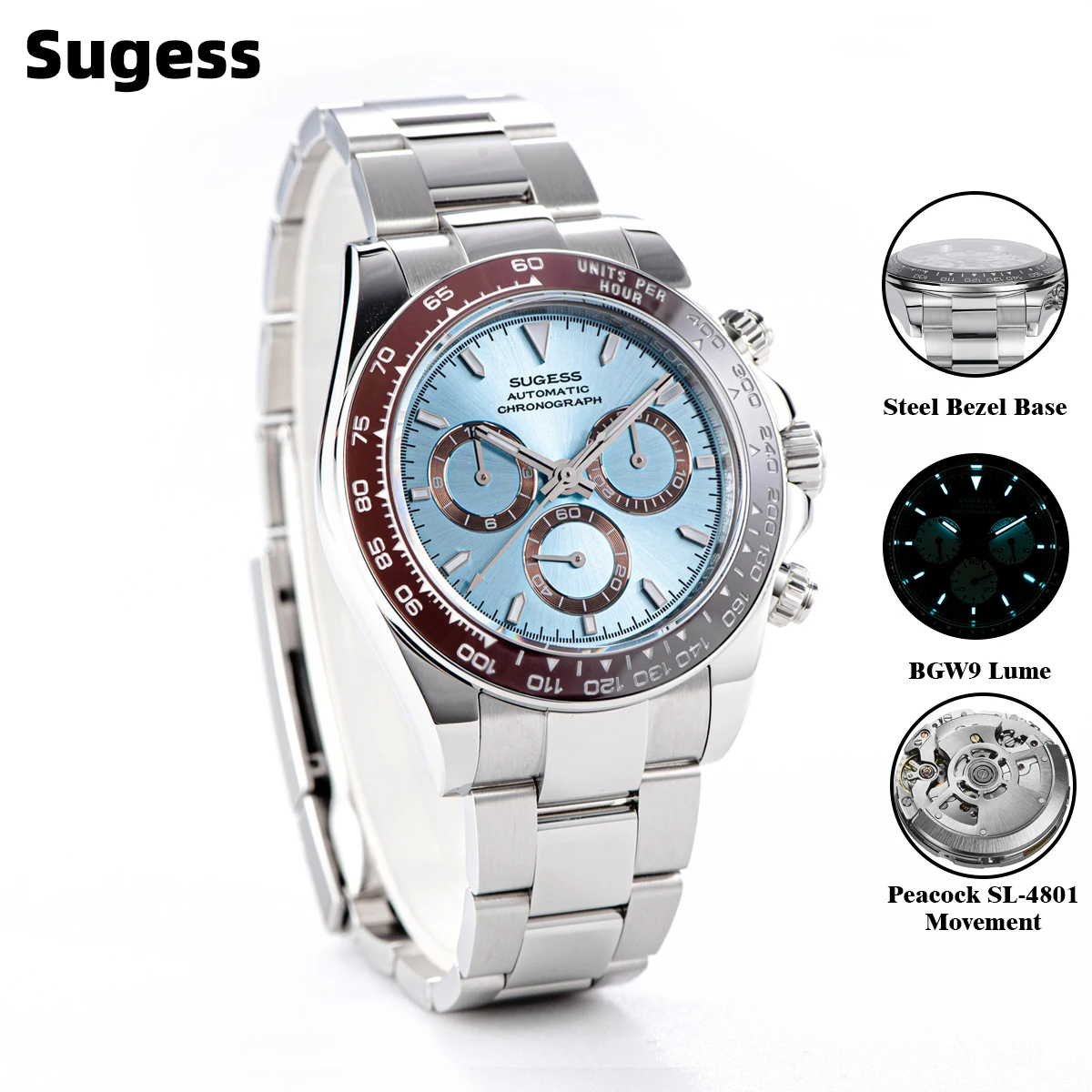
Our selection of automatic chronograph watches demonstrates the engineering advancements that have made these self-winding timepieces increasingly popular among aviation professionals. The convenience factor cannot be overstated, particularly for those who alternate between multiple watches or have unpredictable wearing patterns.
Technical Comparison: Performance Metrics That Matter to Pilots
When evaluating chronographs for aviation use, several technical factors become particularly relevant. This comparison highlights the key differences between manual and automatic movements across metrics that matter most in cockpit environments.
| Performance Factor | Manual Chronographs | Automatic Chronographs |
|---|---|---|
| Case Thickness | Typically 10-13mm | Typically 12-15mm |
| Average Weight | 70-90 grams | 90-120 grams |
| Power Reserve | 40-70 hours when fully wound | 40-70 hours when fully wound |
| Winding Requirements | Daily hand-winding required | Continues self-winding with regular wear |
| Accuracy Variation | Potentially more consistent throughout power reserve | Might vary based on position and mainspring tension |
| Shock Resistance | Good; fewer moving parts | Good; but rotor adds vulnerability |
| Altitude Performance | Excellent; unaffected by air pressure | Excellent; unaffected by air pressure |
| Magnetic Resistance | Varies by model; typically similar | Varies by model; typically similar |
| Service Interval | Typically every 5-7 years | Typically every 5-7 years |
| Field Maintainability | Can be rewound without tools | Requires movement to maintain power |
Impact in Aviation Settings
The effects of G-forces present an interesting consideration. During high-G maneuvers, automatic chronographs may experience rotor “wobble” or unusual winding patterns, though this rarely affects timekeeping accuracy. Modern automatic movements typically incorporate shock absorption systems to protect the rotor assembly.
For long-haul pilots, power reserve becomes particularly important. A manual chronograph left unworn for a weekend might require resetting before the next flight, while an automatic will need either wearing or a watch winder to stay operational.
Temperature variation affects both movement types similarly, but the greater number of lubricants in automatic movements might theoretically make them slightly more susceptible to extreme temperature changes. However, modern lubricants have largely minimized this difference.
Understanding how long automatic watches last provides insight into the long-term value proposition of each movement type. While both movement types offer similar longevity when properly maintained, the convenience factor of automatic winding must be weighed against the increased complexity and potential for more expensive service requirements.
Historical Context: The Evolution of Pilot Chronographs
The development of chronographs for aviation use traces a fascinating evolutionary path that reflects both technological advancement and changing pilot requirements.
Early Aviation Timekeeping (1910s-1930s)
The earliest pilot watches were predominantly manual-wind pocket watches adapted for wrist wear. As aviation developed into a military and commercial enterprise, purpose-built pilot chronographs emerged. These early models were exclusively manual-wind, as automatic chronograph technology had not yet been developed.
During this era, brands created oversized crown designs to allow operation while wearing gloves, and introduced rotating bezels for basic navigation calculations. The manual winding mechanism was perfectly suited to the relatively brief flights of this period, with pilots able to ensure full power reserve before takeoff.
The Golden Age of Manual Chronographs (1940s-1960s)
World War II and the post-war aviation boom saw the refinement of manual chronograph pilot watches. Military specifications drove developments in legibility, durability, and functionality. This period produced many of the most iconic pilot chronograph designs—nearly all featuring manual movements due to their proven reliability and the limitations of early automatic technology.
The hand-wound chronograph became the definitive pilot’s tool, with column-wheel mechanisms providing precise timing functions essential for navigation, fuel consumption calculations, and mission timing. The aviation heritage behind pilot watch features became firmly established during this era, setting design standards that persist today.
The Automatic Revolution (1970s-Present)
The development of reliable automatic chronograph movements in 1969 marked a turning point. Over the subsequent decades, automatic chronographs gradually gained popularity in aviation circles, offering the convenience of self-winding while maintaining the essential timing functions.
By the 1980s, quartz technology had displaced mechanical watches in many professional applications, but both manual and automatic mechanical chronographs maintained their appeal among enthusiasts and many professional pilots who appreciated their craftsmanship and heritage.
Today’s aviation timepiece market features both movement types, with manual chronographs often positioned as premium offerings that celebrate traditional watchmaking, while automatic models emphasize modern convenience alongside historical design elements.
Practical Considerations: Everyday Use and Cockpit Performance
Beyond technical specifications and historical context, the practical experience of using manual versus automatic chronographs in aviation settings reveals important functional differences.
Operation During Flight Activities
For active pilots, the ergonomics of chronograph operation can significantly impact usability:
Glove Compatibility: Both types offer similar pusher designs, but manual chronographs require regular crown manipulation for winding, which can be challenging while wearing flight gloves.
Operation During Turbulence: Starting and stopping chronograph functions is identical between types, but automatic movements eliminate the stability needed for the winding process.
Readability: Case thickness differences are minimal enough that dial legibility is typically unaffected by movement choice, with both types offering similar dial layouts.
Maintenance Realities
Maintenance requirements differ in important ways:
Service Intervals: Both movement types typically require service every 5-7 years, though automatic chronographs with their additional components might show earlier signs of needing attention.
Service Costs: Automatic chronographs generally cost 10-20% more to service due to the additional components in the winding system.
Between-Service Care: Manual chronographs benefit from regular winding even when not worn, while automatic watches should be kept in motion via wear or a watch winder to maintain optimal performance.
Everyday Practicality
The daily experience of ownership reveals distinct differences:
Morning Routine: Manual chronograph owners must incorporate winding into their daily routine, while automatic watch wearers simply put on their timepiece.
Multiple Watch Owners: Those who rotate between several watches may find automatics less convenient, as they require resetting after sitting unworn beyond their power reserve period.
Weekend Transitions: Taking off a watch for weekend activities means manual chronograph owners will need to reset and wind their watches Monday morning, while automatic chronographs might maintain power if stored on winders.
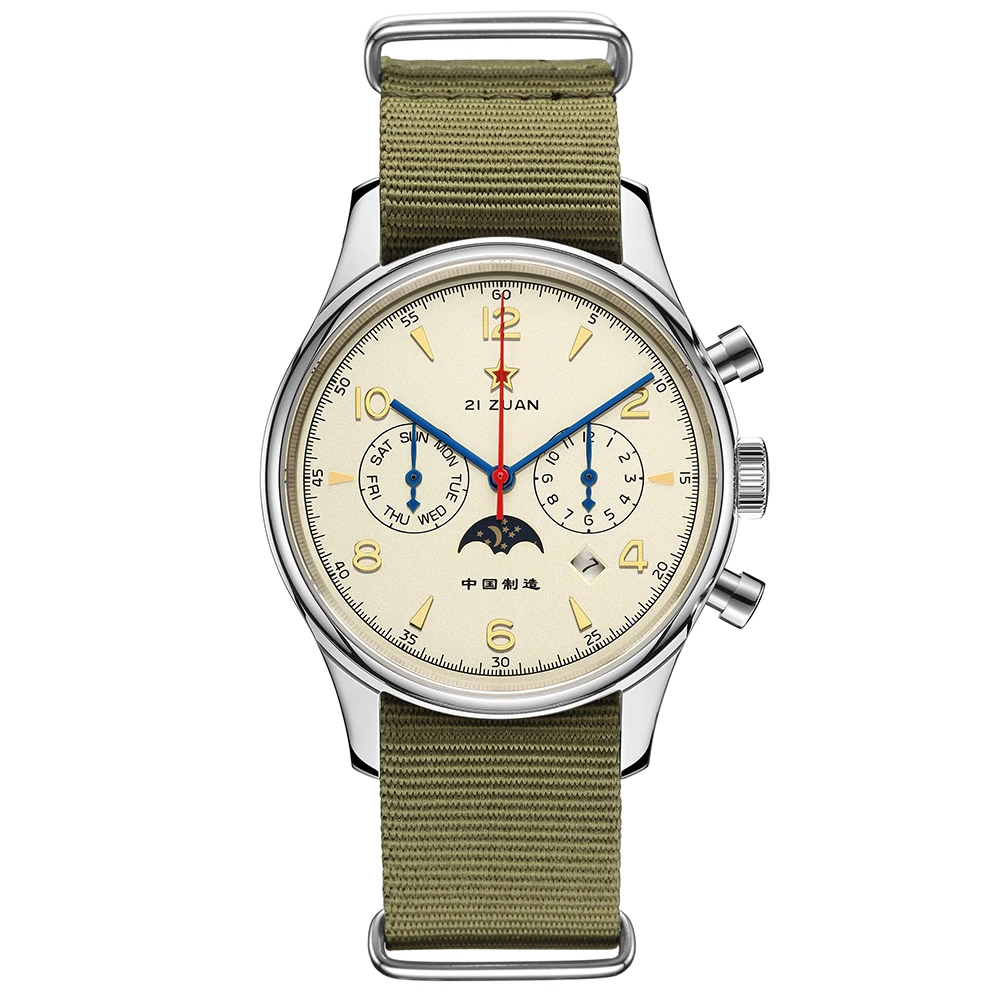
Our collection of chronograph pilot watches includes options designed to optimize cockpit performance with features like anti-reflective sapphire crystals, high-contrast dials, and ergonomic pusher designs. These practical elements complement the movement choice to create timepieces that excel in aviation environments.
Collector Appeal and Value Retention
The investment perspective adds another dimension to the manual versus automatic chronograph decision, with distinct patterns emerging in collector preferences and value retention.
Current Collector Trends
In the contemporary watch collecting landscape:
Limited Production Manual Chronographs: Hand-wound chronographs from prestigious manufacturers often command premium prices, particularly those with column-wheel mechanisms or historical significance.
Vintage Authentication: For vintage pilot chronographs, manual movements are often considered more “authentic” to the golden age of aviation, potentially commanding higher prices among collectors focused on historical accuracy.
Modern Convenience Premium: In contemporary watches, automatic chronographs generally command higher retail prices due to the added convenience and complexity, though this doesn’t always translate to stronger appreciation.
Movement Prestige: Certain iconic movements, regardless of winding mechanism, carry their own collectibility—from the manual Valjoux 72 to the automatic Caliber 11.
Long-Term Value Considerations
Several factors influence the investment potential of each movement type:
Craftsmanship Appreciation: Manual chronographs often showcase traditional finishing techniques more visibly without a rotor obscuring the view, appealing to collectors who value traditional craftsmanship.
Rarity Factors: As production increasingly shifts toward automatics, well-executed manual chronographs become progressively scarcer, potentially supporting stronger value retention.
Service History Impact: Both movement types benefit from documented service history, though the simpler architecture of manual chronographs can sometimes mean fewer costly repairs over decades of ownership.
The intricate art and science of chronograph watchmaking continues to fascinate collectors, with both winding mechanisms offering distinct appeals. Manual chronographs connect owners to traditional watchmaking heritage, while automatic versions represent the innovative spirit of mechanical engineering.
Making Your Choice: Decision Factors for Different User Profiles
Different users prioritize different aspects when selecting a pilot chronograph. Consider which profile best matches your needs and preferences:
For the Active Pilot
If you regularly operate aircraft, your priorities likely include:
- Operational Reliability: Automatic movements eliminate the risk of forgetting to wind before a flight.
- Glove Compatibility: Consider if you’ll be manipulating the crown while wearing gloves.
- Cockpit Ergonomics: Thinner manual chronographs might be more comfortable under tight uniform cuffs.
Key Question: How critical is the convenience of not having to wind daily versus having a slimmer profile on your wrist?
For the Watch Enthusiast and Collector
Those approaching pilot watches from a horological perspective might prioritize:
- Movement Visibility: Manual chronographs often provide better views of the mechanism through display casebacks.
- Historical Authenticity: For collecting vintage-inspired pieces, manual winding may offer a more authentic experience.
- Interaction Experience: The daily ritual of winding creates a connection that automatic watches don’t provide.
Key Question: Do you value the tactile experience and tradition of manual winding more than modern convenience?
For the Everyday Wearer
Those wearing their pilot chronograph as a daily timepiece should consider:
- Lifestyle Compatibility: If you remove your watch daily for sports or other activities, an automatic may require more frequent resetting.
- Comfort Preferences: The weight difference between movement types becomes noticeable during all-day wear.
- Routine Consistency: Your ability to incorporate regular winding into your routine will impact satisfaction with a manual chronograph.
Key Question: Will you wear the watch consistently enough to keep an automatic wound, or would you prefer the control of manual winding?
Automatic Chronograph Watches, Chronograph Pilot Watches
Price range: $233.36 through $237.58 Select options This product has multiple variants. The options may be chosen on the product pageClassic Automatic Dress Watches, GMT Automatic Watches, GMT Pilot Watches
Price range: $1,240.86 through $1,463.33 Select options This product has multiple variants. The options may be chosen on the product pageAutomatic Chronograph Watches, Classic Style Dive Watches
$3,053.06 Select options This product has multiple variants. The options may be chosen on the product pageClassic Manual Wind Watches, Manual Wind Dress Watches
Price range: $425.50 through $462.50 Select options This product has multiple variants. The options may be chosen on the product page- $104.12 Select options This product has multiple variants. The options may be chosen on the product page
Classic Pilot Watches, Military Inspired Automatic Watches
$561.00 Select options This product has multiple variants. The options may be chosen on the product page
Our selection of automatic pilot watches offers excellent options for those prioritizing convenience without sacrificing the distinctive aesthetic and functionality of aviation timepieces. Each piece balances heritage design with modern reliability for daily wearability.
Summarizing the Differences: A Comprehensive Comparison
This comprehensive comparison table highlights the key differences between manual and automatic chronographs specifically in the context of pilot watches:
| Factor | Manual Chronographs | Automatic Chronographs |
|---|---|---|
| Case Profile | Typically thinner by 1-2mm | Generally thicker due to rotor mechanism |
| Daily Operation | Requires daily winding | Self-winds with regular wear |
| Weight | Lighter by approximately 10-30g | Heavier due to additional components |
| Power Reserve | 40-70 hours when fully wound | 40-70 hours when fully wound |
| User Interaction | Daily winding creates ritual and connection | “Set and forget” convenience |
| Historical Authenticity | More faithful to vintage pilot watch designs | Represents modern evolution of the form |
| Movement Visibility | Better view of mechanism (if display caseback) | Rotor partially obscures movement view |
| Service Costs | Generally lower due to fewer components | Typically 10-20% higher due to complexity |
| Cockpit Practicality | Requires pre-flight winding | Maintains power with regular wear |
| Collector Appeal | Strong with traditionalists and vintage enthusiasts | Popular with modern watch enthusiasts |
| Price Range | Varies widely by brand and quality | Typically commands 10-15% premium at retail |
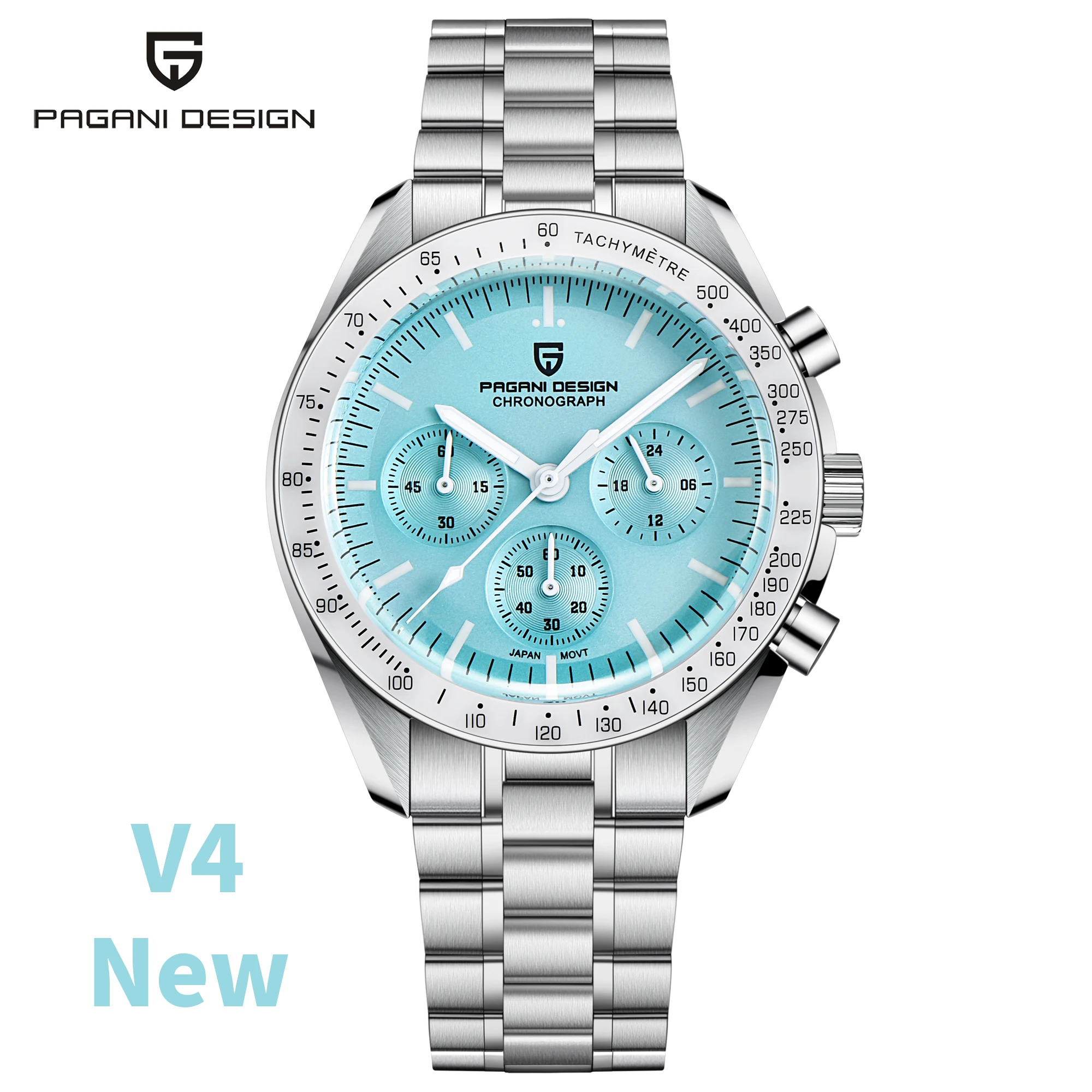
Is One Really Better? The Role of Personal Preference
After examining all the technical differences, historical context, and practical considerations, the question remains: is one type objectively superior? The answer, as with many horological debates, lies firmly in the realm of personal preference.
Manual chronographs offer a direct connection to watchmaking tradition. The ritual of daily winding creates a unique bond between wearer and timepiece that cannot be replicated by automatic mechanisms. For those who appreciate mechanical heritage and the mindful interaction with their instruments, this traditional approach holds profound appeal that transcends mere convenience.
Conversely, automatic chronographs represent the brilliant evolution of watchmaking innovation. Their self-winding capability embodies the very spirit of engineering advancement that has defined aviation progress. For those who value technical ingenuity and seamless integration into modern lifestyles, automatic movements deliver undeniable practical advantages while still honoring the mechanical heart of timekeeping tradition.
FAQ: Common Questions About Manual and Automatic Chronographs
Can you manually wind an automatic chronograph?
Yes, most automatic chronographs can be manually wound by turning the crown in the winding position. This is particularly useful to build power reserve after the watch has been sitting unworn.
Does the chronograph function drain power more quickly?
Yes, engaging the chronograph function increases power consumption from the mainspring, reducing power reserve by approximately 10-20% compared to running in time-only mode.
Which type requires more maintenance?
Automatic chronographs typically require similar service intervals to manual ones (about 5-7 years), but servicing costs are usually higher due to the additional components in the self-winding mechanism.
Are manual chronographs more accurate than automatics?
Movement design and quality influence accuracy more than the winding method. Both types can achieve excellent precision when properly adjusted, though automatic movements may show slightly more position-dependent variation due to the influence of the rotor.

